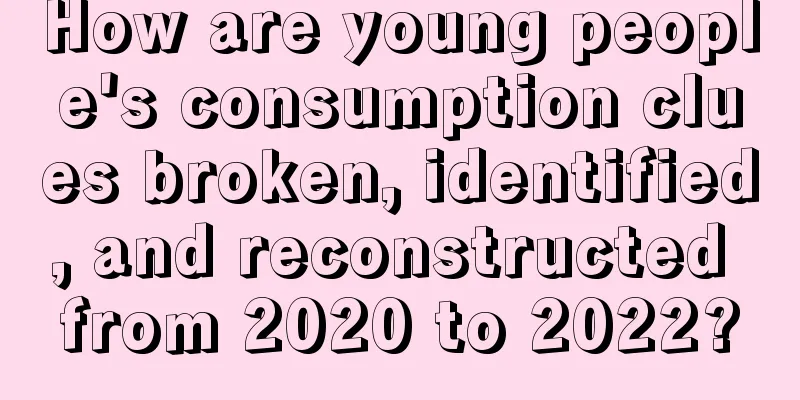How are young people's consumption clues broken, identified, and reconstructed from 2020 to 2022?

Although the green code has become a thing of the past, the changes brought about by the epidemic to individuals are still continuing to ferment. This is a world full of uncertainty, and everyone needs to build high barriers to resist risk. We have seen that young people (mainly Generation Z and those born after 2000), who have the greatest consumption potential and are most knowledgeable about chasing fashion trends, are changing their consumption decisions to save money, increase revenue, or invest in longer-term returns. Three years after the pandemic, they have become more economical, refusing to live paycheck to paycheck or spend money on Huabei, and slowly learning to save money; they seek out substitutes for big brands, from cost-effective domestic products to 1688 platform OEMs, striving to spend every dollar wisely; they have reorganized their workplaces, and cautiously quit their jobs, slowly using their interests to expand their side businesses, often holding multiple jobs, and the lucky ones can earn first-tier city salaries and enjoy the freedom to travel around the world... As young people's consumption desires and consumption concepts continue to be refreshed, their interests and horizons are also stirring up new waves one after another:
The labels/identities/recognitions brought to individuals by the limitations of time and space are constantly being broken and reorganized, and each individual is bursting with more possibilities. Who are these diverse young faces, where do they come from, what are they constantly doing, and why do they love to cross mountains and seas? The Community Marketing Institute will combine the report "Vision-2022 Massive Arithmetic Annual Observation Report" to try to show how the three-year epidemic has affected young people's consumption decisions, and strive to piece together these broken consumption clues to outline a general outline for this magnificent consumer migration. 1. Disruption: In the era of risk, the only way to survive is to keep evolvingIn the VUCA era, no one can predict the next bad news. In 2022, there were too many tragic events worth remembering in China: the crash of an Eastern Airlines passenger plane, a bus accident in Guizhou, frequent wildfires in Chongqing, two major fires in Anyang and Urumqi, Henan, and the death of important leaders...Internationally, abortion rights were overturned, Britain witnessed three prime ministers, a face-slapping incident occurred at the Oscars, the Russia-Ukraine war killed tens of thousands of people, and geopolitics and the epidemic caused many countries in the world to create new records of inflation... Under the impact of many major events, more and more people realize that risk may be the norm in the human world. How do young people perceive the risks in this world, reduce anxiety, and keep moving forward? If young people are defined as those born after 1995 and 2000 (as defined by many media and reports), then the oldest group born after 1995 have already entered the workplace for 3-5 years. If they are successful in their careers, they have entered the core management of company departments and have become one of the most staunch consumer forces in this society. The youngest group born after 2000 are about to enter/have already entered university. They have endless hot topics and interesting things to catch up on every day, and their preferences can most clearly reflect the changes in consumption trends. In the three years since the epidemic, the increase in the length of online classes and online office work is one of the changes that young people have felt most intuitively. The increase in the time spent online has directly led to a massive explosion of unboxing/experience/sharing/reviews/tutorials/strategies on various social platforms. Young people are more proactive in embracing digital media, hoping to make more efficient and valuable screening among the complex marketing audio-visual content, and learning consumers are emerging. According to statistics from Juliangsuansu, more than half of the learning content providers (full-time content creators on Douyin) are young and middle-aged people aged 31-50, and the proportion is increasing. They have more things to talk about in their lives and are more likely to gain 10,000 fans. In terms of learning object preferences, learning consumers trust more affinity and more resonant kol/koc, and do not blindly rely on authority. In terms of content tone preference, the key points that learning consumers pay most attention to in content creation are close to personal life (69.9%), objective perspective and true content (67.6%); in terms of content field preference, the best performing areas in the food, clothing and daily necessities sectors in the past year were healthy ingredients in food and beverages (80%), craftsmanship style of clothing, shoes and bags (66.3%), and ingredients and efficacy of beauty and personal care products (50.6%). Many young people hope to continue their study/work style with only a computer and an Internet cable after the epidemic. According to data from the Ministry of Human Resources and Social Security, the number of flexible employment workers in China will reach about 200 million in 2021. The reason why the number of flexible employment people is so spectacular is that young people have abandoned the idea of working after graduation and having continuous work, but they do not really want to "rectify the workplace". Instead, they choose to reconcile with their imperfect selves through learning from workplace dramas/variety shows/workplace predecessors, be more calm and Buddhist about life, and choose a more flexible and free way of corporate organization, and say goodbye to official language/making PPT reports/punching in at a fixed time. Among them, some people stay at home and/or do odd jobs, hoping to reach a new level by taking postgraduate entrance exams/civil service exams/certificate exams with longer-term returns; some people develop their interests into odd jobs during college (such as short video content creation, which itself matches the way young people record their lives and also hits the dividends of the times, with brands spending money like crazy), and after graduation they can develop odd jobs into a lifestyle; some people enjoy the dividends of the times of corporate reform and organization, and online office work has become the norm. They can get the wages of high-tier cities and enjoy the low costs and slow pace of low-tier cities. According to statistics from Juliangsuansu, overall, internet marketers, public account bloggers, e-sports players, freelance writers, and independent designers are the most popular types of freelance jobs among young people; among the interviewed Douyin users born after 2000, the proportion of freelancers is second only to the group of students; more than half of the working people born after 2000 have part-time jobs, and they prefer to work in professional and technical fields such as education, law, finance, consulting, photography, etc. (15%), and social bloggers on graphic, text and video platforms (9.5%). They prefer to be social bloggers (2.1%), franchise store owners (0.6%), and script-killing hosts (0.6%) more than people of other age groups. Now, local digital nomad communities have emerged in Dali, Yunnan, Wanning, Hainan, and Anji, Zhejiang, and the core group of the communities are mainly young people who have just graduated. The change in learning and working methods has led young people to pursue a new lifestyle:
According to the statistics of Jueliangsuansu, the fastest growing content directions and hot topics in the past year were daily fitness (including Compendium of Materia Medica, Pamela, Lamu Yangzi, aerobics, etc.), home life (celebrity home observations, staying at home with Liu Genghong, the home quarantine version of "Love You" is coming), embracing nature (camping for beginners, camping costumes, camping after the epidemic, etc.), and shooting to promote popularity (check-in for "The Legend of Sword and Fairy 1", national check-in for ice and snow, immersive check-in for Xidian Canteen, etc.). At the breaking point of the times, only by continuing to evolve can we reduce anxiety to the greatest extent possible. It is foreseeable that as the post-epidemic relaxation comes, young people's learning and working methods will continue to change, and their way of looking at the world will become more mature and concrete. Some consumption habits will be solidified as a result, such as business formats that require online to offline traffic diversion. Some industry dividends may disappear, such as some small household appliances that not only gather dust but also pay an IQ tax. The passion that shines brightly in the eyes of young people is still changing. 2. Recognition: There is thunder in silence, and tiny love has a vast universeIn the vast online space, many products that were difficult to reach/removed from the shelves are now visible again. What young people lack the least is time. At their prime years, they suck up the excessive information given by the times like a sponge, and grab the shining shell that belongs to them alone. These treasures circulating on social platforms originally came from sharing of social desires, resonance with the same circle, comparison of winning and losing, and identification of individual identity, and then were paid for by brands, especially a large number of domestic brands, forming one of the most dazzling wealth-making movements in the three years of the epidemic. These young people may be inexperienced college students, sales clerks, lifestyle experts who have awakened to their interests earlier (such as skin care or skateboarding), or have a study/work background in vertical fields. Their talents/skills bring traffic to the brand and also bring it closer to consumers. This is a tug-of-war between time and space. Mottled things will be painted with shiny paint by brands and consumers and embark on a cultural renaissance. Regional scenery, characteristic products, and regional brands that were once hidden by mainstream discourse will also skyrocket in value under the powerful cultural filter. Those amateur bloggers who can endorse their hometowns, promote local specialties, and often have outstanding talents will be favored by netizens. In 2022, we saw that national style IPs such as Dunhuang murals, Only Green, and Tang Palace Night Banquet frequently went viral. This was mainly due to the fact that young people (TGI for those aged 18-23 reached 181, far exceeding the level of those aged 24 and above) were able to spread intangible cultural heritage in a youthful language and through spontaneous creation and submission. For example, Guo Xiaojing, an intangible cultural heritage creator on Douyin, is a professional Peking Opera actor born in the 1990s. He was able to incorporate elements of popular culture into the process of popularizing Peking Opera culture, including sharing Peking Opera makeup/removal techniques and creating Peking Opera cross-dressing videos, which brought him closer to the audience. Those who are more fortunate and gifted, such as Ding Zhen and his Litang County in Ganzi Prefecture, can win the local name card of Ganzi just by relying on their handsome face, clean smile and rugged scenery. As of December last year, the cumulative number of fans of Ding Zhen's account in Litang reached 8 million. When the advantage of appearance is magnified, there are also many young people who want to get closer to Tibetan culture. The disappearance of time and space boundaries has further smoothed out information asymmetry and consumption differences between regions. With the help of China's powerful supply chain and logistics system, popular online celebrity products can cover the needs of people in high- and low-tier cities without distinction. In the two major categories of clothing and mobile phones and digital products, the gap in the proportion of purchasing users between urban and rural areas has even narrowed to less than 4%. In a shorter time and space, young people begin to re-examine their lives. Outdoors, in indoor commercial spaces with a coverage radius of 1-3 kilometers, searches for indoor bungee jumping, indoor skiing, and indoor surfing increased by 300% year-on-year in January-February 2022. Niche sports such as golf, squash, fencing, softball, and rock climbing are becoming new favorites; city squares with a coverage radius of more than 5 kilometers are being lit up by colorful camping tents, special markets (trunk markets), and skateboard enthusiasts; in the suburbs of cities that can gather urban traffic, land rushing, river tracing, and paddle boarding are the fastest growing emerging sports in 2022, and relatively old school hiking is also continuing to grow. When at home, young people want to free their hands and enjoy a high-quality life. As a result, kitchen/cleaning appliances with good looks and high technology have become the focus of public discussion in the past three years: Is it a waste of money or a lazy artifact? Is it highly versatile or has useless functions? The debate has never stopped. The only certainty is that categories with certain growth, such as air fryers, floor scrubbers, home projectors, and coffee machines, have high usage stickiness (such as coffee machines), versatility in scenarios and functions (such as air fryers and floor scrubbers), or meet the needs of segmented scenarios (home projectors). The commonality of the above categories is that they all significantly improve the sense of happiness in life and meet the needs of young people for early anti-aging and punk health. According to statistics from a large number of arithmetic, young people under 30 in high-tier cities, rather than middle-aged and elderly people, are the main force driving dietary health in the past year. In addition to re-examining their living environment, young people are also paying more attention to themselves. In terms of body shape and appearance management, gender labels are even broken, with men becoming more refined and women more manly. According to statistics from Juliangsuanshu, there are three aspects that show that men are more refined:
In terms of the manifestation of female macho, according to the statistics of Juliang Suanshu, the TGI of girls aged 24-30 and 18-23 who prefer cool/handsome products with traditional masculine temperament reached 116/147 respectively. In recent years, some men's clothing brands such as Sushou are popular among women mainly because of their gender-neutral design style. Unisex has also become the top ten hot styles in Douyin in the past year. Bosie, Nai Dao, and Oinkpink are all focusing on gender-neutral clothing. In addition, among users with specific interests that seem to be masculine, such as AR/video games/motorcycles, the growth rate of female users has exceeded that of male users. Under the meticulous self-attention of young people, the passion for sports and fitness can also be ignited indoors. In the field of sports, according to statistics from a huge number of statistics, Douyin has 470 million sports-interested users (based on the statistics of frequently browsing sports content), of which more than 260 million express their love for sports content by frequently liking; in the field of fitness, Liu Genghong's account gained 9.2 million followers on April 21, and the number of viewers in the live broadcast room on that day reached 57 million+; Keep's prospectus disclosed that among the fitness population in China, the proportion of online fitness users reached 45.5%. The logic behind home exercise/fitness is that, regardless of whether the gym is open or not, having simple equipment such as a fitness mat/elastic rope/dumbbells at home can significantly reduce the decision-making cost of "whether to exercise today". If there is an online coach, it will be more motivating to learn and practice, and the development of online fitness platforms such as Keep allows young people to record their physical training results more actively and timely. In addition to self-attention, projecting gazes and emotions is also a way of expressing oneself. Compared with the spiritual resonance of being close yet distant and preferring the new to the old (virtual idols/niche trendy toys/high-quality mobile games/& movie screens), young people living alone have a clearer need for physical companionship. The cats, dogs, flowers and plants that are full of life and are with them day and night are bound to be fiddled with. However, young people who raise flowers and plants are still a minority (TGI is only 54), and young people prefer to raise pets to relieve loneliness (TGI is 141). During the three years of the epidemic, although the proportion of cat owners slightly exceeded that of dog owners and maintained a faster growth rate, in the past year, the pet content that Douyin users liked most was still dog-related, including golden retrievers, corgis, Shiba Inus, and Alaskans; the fastest-growing types of exotic pets were dragonflies (951%), crickets (514%), snakes (195%), butterflies (190%), frogs (138%), and pigeons (109%); the most liked flower and plant content was bamboo, orchids, succulents, and lilies. In short, the scope of interests has been greatly expanded, the degree of self-attention is unprecedented, and they are willing to spend money for the objects of empathy. This is the true portrayal of contemporary young people. 3. Reconstruction: The younger you are, the more you need to eliminate this time and space boundaryBeing young is itself a kind of restless uncertainty. When risks come like a flood summoned by an oracle, young people who are most active and complain the most on social platforms are also the ones who can learn and adjust the fastest. They are the ones who can evolve new wings along with the risks, choose the wind at the right time, and take off. So, on the surface, they are unemployed after graduation and use the values of the new era to reorganize the workplace, but they are also developing the ability to take on multiple jobs and upgrade their interests into skills/odd jobs/careers, and using more diverse cost-saving/increasing income/long-term investment ideas to pay for their passion. Fortunately, some young people have already stepped into the dividends of the times. They either serve as a medium connecting brands and consumers, or as holders of professional skills such as consulting/finance/freelance writing/photography. In any case, they have a freer and more relaxed attitude/way of life. They are more willing to pay for their passion and are constantly breaking the market's outdated impression of them. From the revitalized national IP to the landscape specialties with regional characteristics, from the popularity of sports in the suburbs of the city to the treasures of visiting unpopular stores, from caring about food/cleaning and other material needs at home to the desire for long-term companionship of spiritual and physical objects... We see that in an era of risk, young people not only desire the emotional satisfaction of being healed, moved, and connected, but are also seeking more stable and long-term certainty in order to evolve themselves. Behind this is both a firm belief in the fundamentals of life and a kind of youthful vitality. The epidemic lockdown is over, but this consumer migration is just the beginning. Source: Community Marketing Research Institute (ID: Community_Marketing), insights into community consumption |
Recommend
Changing your name can change your brand's fate
This article uses different brand name change case...
Pinduoduo Temu dolls, figures, models, and ornaments hot-selling list
Pinduoduo Temu Toys and Games > Toy Figures and...
How to optimize keywords on Amazon? What are the methods?
On Amazon, you can generally choose to use keyword...
Video account launches hot-selling product list
The video account selection center has launched th...
5 Ways to Play Metaphysical Marketing
When metaphysics began to enter the young group, m...
In-depth Analysis | How did Sumida River Coffee upgrade its logo, symbol, brand color and packaging based on its brand genes?
Sumida River Coffee - step by step upgrades in log...
Please note that this is the first Olympics where advertising is sold programmatically.
The Paris Olympics pioneered programmatic advertis...
Google's textbook AI fightback
This article mainly describes the series of counte...
Lei Jun has nearly 7 million fans. In addition to using domineering internet celebrities, how else can car companies market themselves?
This article delves into how automakers use live s...
Young people who left big companies regret not leaving earlier
Large companies are like a besieged city. People o...
How to optimize the name of Shopee store? Complete naming skills
Opening an attractive and unique store name on the...
How to calculate Amazon warehouse capacity? What is the method?
To open a store on Amazon, you not only need to le...
How long does it take for Amazon FBA to compensate for lost shipments? How do I file a claim?
After we shop on the Amazon platform, we just need...
Should I continue to work on Shopee if I haven't graduated from the incubation period? What are the operation skills?
When it comes to opening a new store on the Shopee...
What are the three types of Amazon sellers?
In addition to different sales models, Amazon also...









